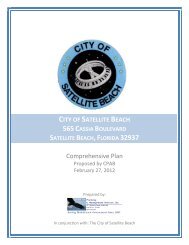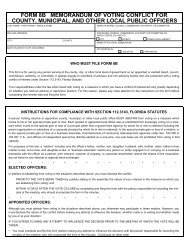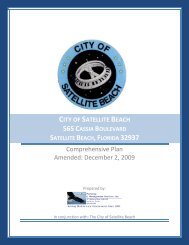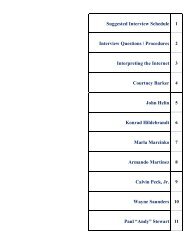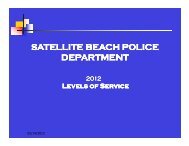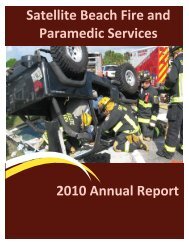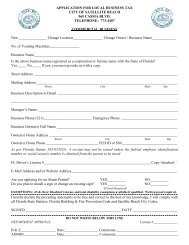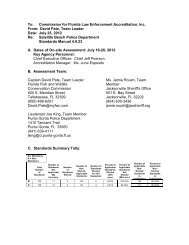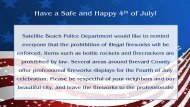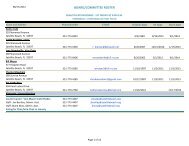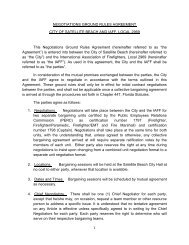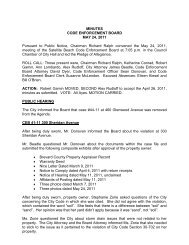Supporting Documents (Data and Analysis) - Satellite Beach
Supporting Documents (Data and Analysis) - Satellite Beach
Supporting Documents (Data and Analysis) - Satellite Beach
You also want an ePaper? Increase the reach of your titles
YUMPU automatically turns print PDFs into web optimized ePapers that Google loves.
class projects on Samsons Isl<strong>and</strong> Nature Park to assist in devising <strong>and</strong> implementing maintenance<br />
programs to preserve <strong>and</strong> enhance desirable wildlife habitats.<br />
The loss of habitat for endangered/threatened species is always a concern in areas undergoing<br />
urbanization. Previously, replacement of a species was part of the natural process of faunal<br />
succession, allowing other species to supplant those which declined or disappeared due to changes in<br />
their niches <strong>and</strong> habitats. However, species are now approaching extinction at a rapid rate as a result<br />
of direct <strong>and</strong> indirect human activities which lead to loss of habitats. Besides threatened,<br />
endangered, or species of special concern, other native animal populations within City boundaries<br />
include rabbits, mice, rats, bobcats, armadillos, opossums, raccoons, squirrels, snakes, turtles, a wide<br />
variety of birds, <strong>and</strong> numerous species of small lizards, reptiles, <strong>and</strong> insects. According to Dr.<br />
Herbert Kale of the Florida Audubon Society, approximately 200 different species of birds can be<br />
observed in <strong>and</strong> around <strong>Satellite</strong> <strong>Beach</strong> over the period of a year, <strong>and</strong> up to 300 species over a period<br />
of several years.<br />
In 1956, a north-south canal was dredged for mosquito control. The dredge spoil was placed on the<br />
mangrove marsh area immediately to the west, thereby forming the isl<strong>and</strong> area characterizing the<br />
westernmost l<strong>and</strong> portion of the City. During the next several years bulkheaded finger canals were<br />
dredged east of that canal to provide l<strong>and</strong> for development as waterfront residential properties.<br />
These activities resulted in loss of a broad expanse of wetl<strong>and</strong> habitats, dominated by mangroves,<br />
which had previously stretched from the approximate location of the north-south canal (Gr<strong>and</strong><br />
Canal) westward to the Banana River.<br />
On the east side of the Barrier Isl<strong>and</strong> lies the Atlantic Ocean. The marine waters with a s<strong>and</strong>-coquina<br />
bottom extend from the shoreline to the continental shelf offshore. This area is categorized into two<br />
major zones--intertidal <strong>and</strong> subtidal zones--which support differing biological communities.<br />
The intertidal zone experiences the regular pounding action of the waves <strong>and</strong> the constant littoral<br />
drift of sediment along the shoreline, resulting in a high-energy environment. The inhabitants of this<br />
area include the mole crab, ghost crab, <strong>and</strong> other mollusks <strong>and</strong> crustaceans. Other transient species,<br />
such as bluefish, king mackerel, Spanish mackerel, channel bass, pompano, <strong>and</strong> black drum, also are<br />
found here. The major bird species that use this area for feeding, breeding, <strong>and</strong> nesting are: willets,<br />
plovers, s<strong>and</strong>erlings, terns, pelicans, <strong>and</strong> gulls.<br />
The subtidal zone provides a suitable environment for planktivorous species, such as shrimp <strong>and</strong><br />
other crustaceans, mollusks, <strong>and</strong> other benthic organisms, as well as carnivorous fish species which<br />
prey on the abundant planktivores.<br />
Both the Banana River <strong>and</strong> the Atlantic Ocean are Class III waters, which allows for recreation <strong>and</strong><br />
the management of fish <strong>and</strong> wildlife. Populations of both finfish <strong>and</strong> shellfish in the Banana River<br />
have declined with increased development, due to over-harvesting <strong>and</strong> pollution. The decline in<br />
water quality in the Banana River is a result of both point source <strong>and</strong> non-point source pollution.<br />
According to Florida Sea Grant Technical Paper No. 44 (Overview of the Indian River Lagoon), the<br />
Banana River south of the Pineda Causeway showed signs of nutrient enrichment, primarily due to<br />
wastewater discharges by sewage treatment plants in the area at that time. Since 1989, State law has<br />
Coastal Management/Conservation Element<br />
<strong>Data</strong> <strong>and</strong> <strong>Analysis</strong> 5-11



